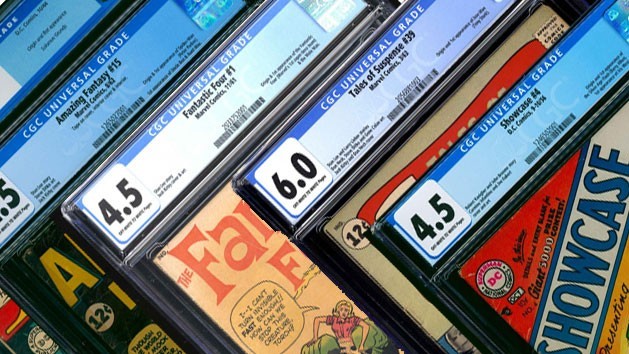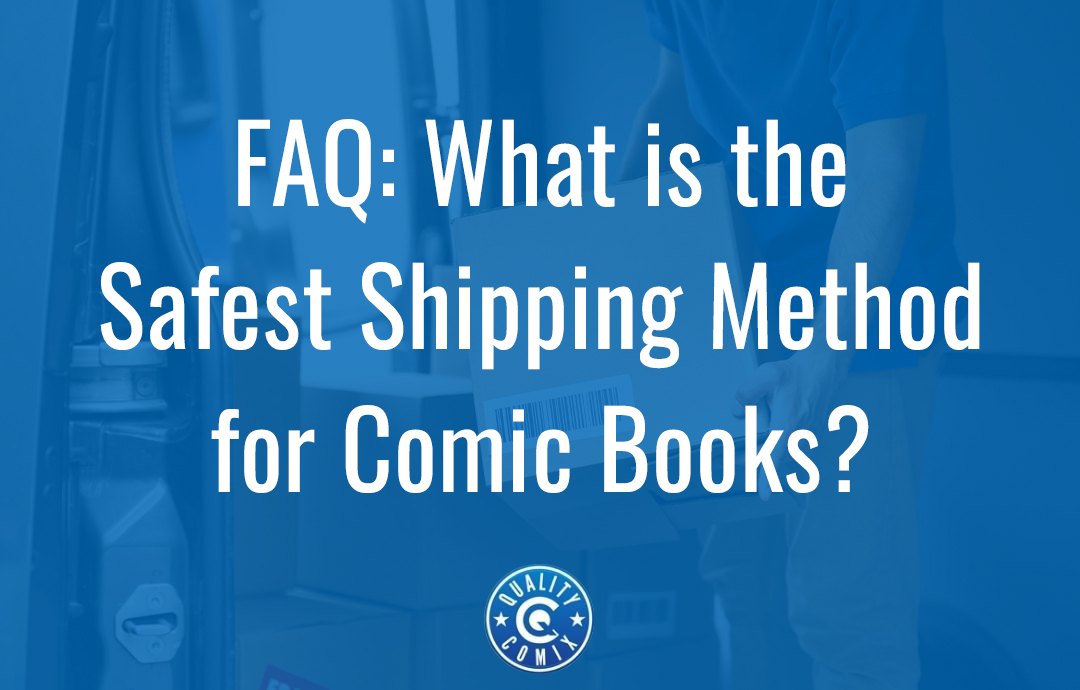
There are many different ways to buy and sell comics. A business can hand you in-person customer sales in a shopping bag, but what if you sell to or buy from someone online? Whether they're across the state or the country, the comics you buy or sell online must be shipped.
Shipping is, unfortunately, fraught with peril. Even before the logistics issues that came with Covid, there were the occasional problems with shipping, like damage to your package in transit, stolen packages, lost items, and more.
Since the pandemic and the associated drops in shipping quality, increased rates of package theft, and other issues, it's only gotten more complicated.
That's not to say that you can't ship comics. It means you must send your valuable comics the right way to ensure the best possible experience for both seller and buyer.
Table of Contents
- What Is the Safest Way to Ship Comics?
- What Class of Shipping Should You Get?
- Is It More Expensive to Ship Graded Comics?
- How Do You Properly Pack Comics to Ship?
- Should You Print Your Shipping Labels?
- Should You Get Insurance?
- Should You Get Delivery Confirmation?
- How Fast Should You Ship?
- Any Tips or Advice?
What Is the Safest Way to Ship Comics?
Unfortunately, there's no such thing as the "safest way" because shipping services are very regional.
For some people, the USPS is the most reliable. For others, USPS packages have problems and delays, while FedEx or UPS is more reliable.
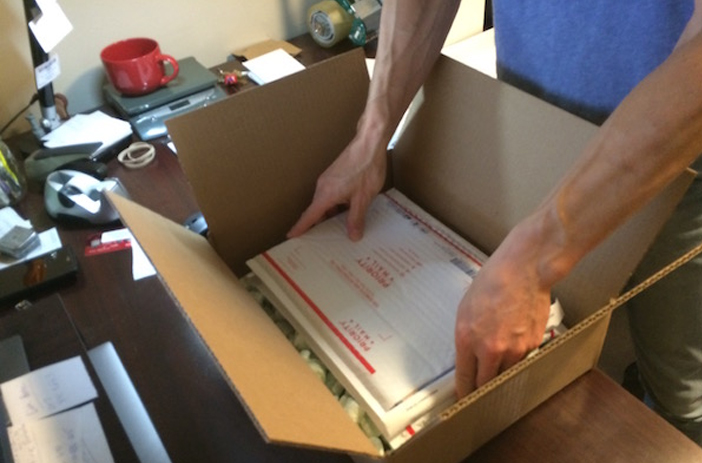
If you're buying comics, you might consider asking the seller what shipping options they offer and working with them to pick the most reliable one in your area, at least to the best of your knowledge.
Conversely, if you're selling comics, you'll want to ship with whatever the most reliable service is where you're sending the books. USPS, FedEx, and UPS are all viable options. DHL often has a worse reputation in the USA but could be a viable option internationally. Also, did you know that USPS ships internationally? It's true, and they're a viable option for many.
The safest way to ship is with a method that is recommended by the buyer, in a rigid and properly-packed box, and with insurance.
We'll dig into each of these three requirements momentarily.
What Class of Shipping Should You Get?
When purchasing shipping for comics, you have the chance to specify the class of shipping. For example, with USPS, you can pick between Priority Mail, First Class, and Express Mail, among other add-ons.
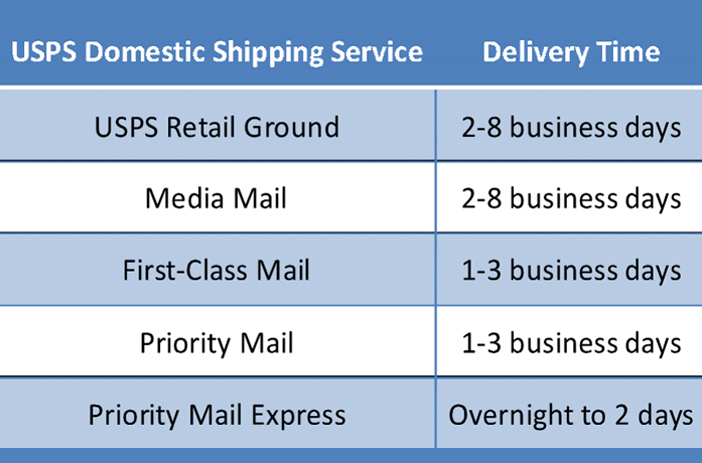
Though "first class" is usually the term that flags the best service, that's not the case with USPS mailing services. With USPS, "first-class" shipping is simply the baseline for priority services over the basics like marketing mailers and media mail. It's great for smaller and lower-value items, like bulk comics shipped in small batches, but it's not as good for larger packages or more valuable items, at least not without add-ons.
Unfortunately, First Class Shipping via USPS has been slower recently, so Priority Mail is often the best choice.
Is It More Expensive to Ship Graded Comics?
In general, yes!
Graded comics are slabbed in rigid plastic containers. This process protects them from stray damage during handling, but it makes them larger, bulkier, and heavier, increasing the shipping cost. Also, graded comics are generally more expensive than ungraded comics (most of the time, not all of the time), which means higher shipping costs and additional packaging for protection.

For example, here's some data from our shipping page.
- USPS Priority Mail Insured Shipping for 1-3 raw books: $9
- USPS Priority Mail Insured Shipping for one graded book: $12
- UPS Ground Home Delivery for 1-2 graded books OR 1-12 raw books: $18
Shipping rates also scale up faster the more graded books you're mailing because each book takes up significantly more space and weight than adding a few ungraded comics to a box. This phenomenon is why it costs roughly the same to ship 30-90 raw books and only 4-15 graded books.
How Do You Properly Pack Comics to Ship?
If you're shipping comics, you want to ensure they're packed carefully and correctly so they don't get damaged in transit. How do you go about doing so? Here's what you need:
- Shipping Envelopes or Boxes
- Stiff Cardboard Sheets
- Packing Tape
- Masking Tape
- Permanent Marker
- A Postal Scale
- "Bag and Board" Packages
Start by bagging and boarding your comics individually, the way you would for any storage method. If you're unfamiliar, this method uses a plastic bag to fit a comic and a thin sheet of stiff cardboard to lend stiffness to the comic and prevent bends and creases. Pack each book up in these storage bags. Make sure to seal the top to avoid the comics slipping out if your package is upside down! Here's a good guide on this process. If you're unsure where to get bags and boards, your local comic shop likely has them for sale, or you can get some from a reputable brand like BCW.
Next, use scissors or a box cutter to cut sheets of stiff cardboard slightly larger than the bagged-and-boarded comic. You want two sheets of the same size. These will "sandwich" the comic between them.
Use masking tape to secure the bagged comic to the cardboard. Masking tape is easy to remove from a comic bag, but you can also create pull tabs by folding over the tips of the tape. Your goal is to secure the comic to one sheet of cardboard and layer another on top of it. This added layer of stiffness and protection prevents possible damage to the comic short of a catastrophe.
If you're only shipping a few lower-value comics, you might be tempted to slip these comic sandwiches into a padded mailer with a cardboard sleeve to protect it from bends. Most comic businesses (including us) generally recommend against this, as a properly packed box is much less likely to bend and hurt your comics than a flimsy envelope is.
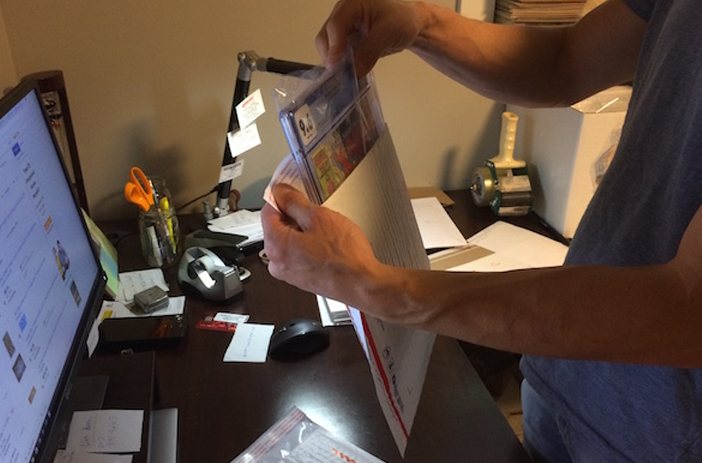
If you have more comics to ship, you will want a larger box to hold them. Make sure to get the smallest bag or box into which you can fit your comics to avoid excess space jostling them around. You can include extra cardboard, bubble wrap, or another packing material to fill excess space if necessary.
Note: If you want to ship the DIY process and buy pre-made cardboard mailers to secure your comics, you can use something like these. They're more elaborate and precision-engineered for comics but significantly more expensive. It's a small price if you're shipping more valuable comics, but it's usually unnecessary for bulk and lower-value comics.
While you don't need the postal scale, it can help to know the weight of the finished package so that you can estimate the shipping cost and if you choose to buy and print shipping labels from home. Otherwise, the postal service you use will weigh and calculate it for you when you bring it to their office to mail.
With graded comics (aka comics that are "slabbed"), they are already primarily protected in their plastic shells. However, you don't want that shell to be damaged, so it can still be beneficial to use filler cardboard and additional bubble wrap or packing material to prevent them from banging into each other or around inside a box.
Should You Print Your Shipping Labels?
One question you might have is whether you should print your shipping labels or take your package to the post office, local UPS, or other shipping company's retail location to mail it.
The answer here depends on how much you trust the service to pick up and process your package and how accurate your equipment is at home.
As long as the weight is accurate and your information is verified, there's not much difference between printing a label at home or taking your package into an office to be mailed. It would help if you had a label printer at home, but that's the only significant difference.
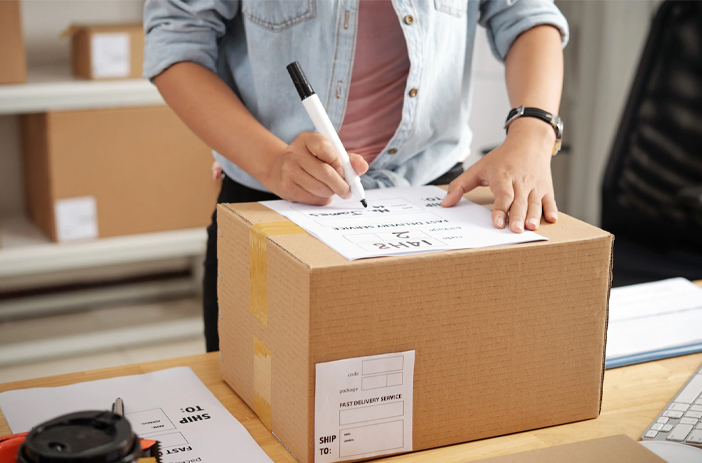
Additionally, you can use services like PirateShip to get a discount on shipping if you ship frequently.
That said, if your package is of significant value (thousands or more dollars), it may make sense to take it to an office to mail it. This option skips one handling step (the pickup), which is one less failure point along the way. You should also insure your package for the total value, especially if it's an expensive comic book or collection.
Should You Get Insurance?
In almost every case, yes, getting insurance on the packages you ship is a good idea. The exception is when you're only shipping a couple of bulk comics with a value under $100; in these cases, the insurance cost might not be worth the additional hassle and the minimal potential benefits in the case of disaster. After all, will your recipient pursue an insurance claim for such a low-value package if it's damaged?
That said, you can leave this decision to the buyer. Insurance costs can be added to the price of shipping and handling when you charge the buyer, and you can work it out with them whether or not they want insurance, particularly on small and low-value packages.
We would only ship something of moderate to significant value with insurance.
Imagine if a buyer wants to save a few bucks on insurance, only for a $10,000 comic to be damaged or lost in the mail! That's both a catastrophe and an easily-avoided problem, and insurance doesn't cost that much extra.

Remember, as well, that some shipping forms have insurance by default, but that insurance might only go up to a specific value, and you'd need to purchase additional insurance for higher values in a single package. Make sure you discuss this with your carrier! With UPS, for example, their automatic $100 liability coverage won't do you much good on a $10,000 comic that was lost or damaged in transit.
Should You Get Delivery Confirmation?
Unlike insurance, delivery confirmation is a trickier issue. This decision is much more of a buyer preference.
For example, if the buyer is shipping to a secure location they trust, they don't have issues with package theft, and they aren't likely to be home when the package arrives, shipping confirmation can be a delay and a hassle. After all, if the box requires a signature and no one is there to receive it, the buyer must go to the post office to retrieve it, often after several failed delivery attempts.

Anecdotally, since Covid, many "signature required" deliveries are left without getting a signature anyway. While this is less likely for high-value and insured packages, it can still happen.
It may not necessarily be worth paying for signature verification. That said, it's usually just a couple of dollars extra and may still be worth it, just in case. This decision is largely up to you and the buyer to work out.
How Fast Should You Ship?
Another choice you have to make is how fast to ship your comics. Faster shipping, like two-day air delivery, will cost significantly more, especially for larger packages like graded comics. On the one hand, speedier delivery adds peace of mind to the transaction; you and the buyer know that there will only be a day or two of anxiety before the delivery date.
On the other hand, shipping is a mess throughout the country, and even a two-day delivery isn't guaranteed. Logistics is complex, and all major shipping companies have problems with volume, staffing, unexpected weather delays, etc.

Remember, as well, that international shipping is often unavoidably delayed, so paying for priority shipping might not speed it up.
In general, the higher the value of the package, the more worthwhile it is to ship quickly.
Shipping speed is lower on the items of concern when shipping comics, though.
Any Tips or Advice?
While we mentioned padded mailing envelopes above, these are still risky. It would be best if you didn't use a padded mailer with higher-value comics (and the standard pricing makes it worthwhile for a few lower-value comics at a time). If you still decide to use these for lower-value comics, you still want to include extra cardboard to keep the comic stiff in transit so that it doesn't bend. Otherwise, use a box.
Remember, too, that if you process transactions in various ways, there are additional layers of protection. For example, credit card purchases may offer their insurance, PayPal and eBay have their buyer protection, and so on. Third-party transactions through private websites or sites like craigslist are less likely to have additional recourse if something goes wrong.
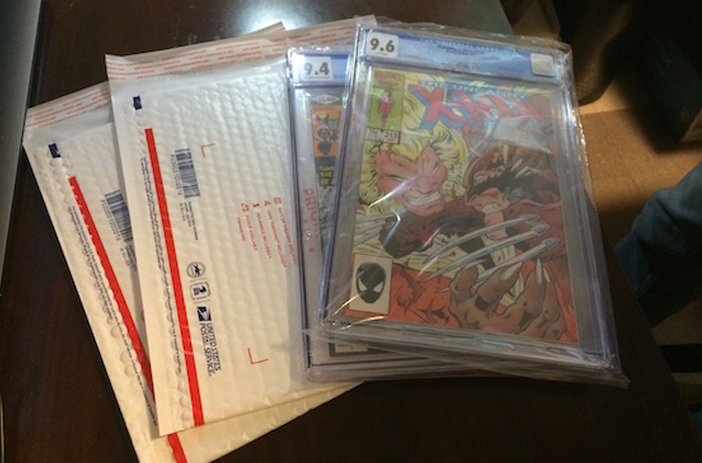
If you're thinking of selling your comics and shipping them to somebody, make sure you get your comics appraised with us first! We'll give you our best offer on your comics, and at the very least, it's helpful to know the value of your comics. You can submit a free appraisal request here, and we'll get back to you shortly with an offer.
Do you have any questions about shipping comics we haven't covered in this post? If so, feel free to leave that question in the comments or reach out and ask us directly. Just let us know! We frequently ship moderate to high-value comics, and we've gotten pretty good at it.

